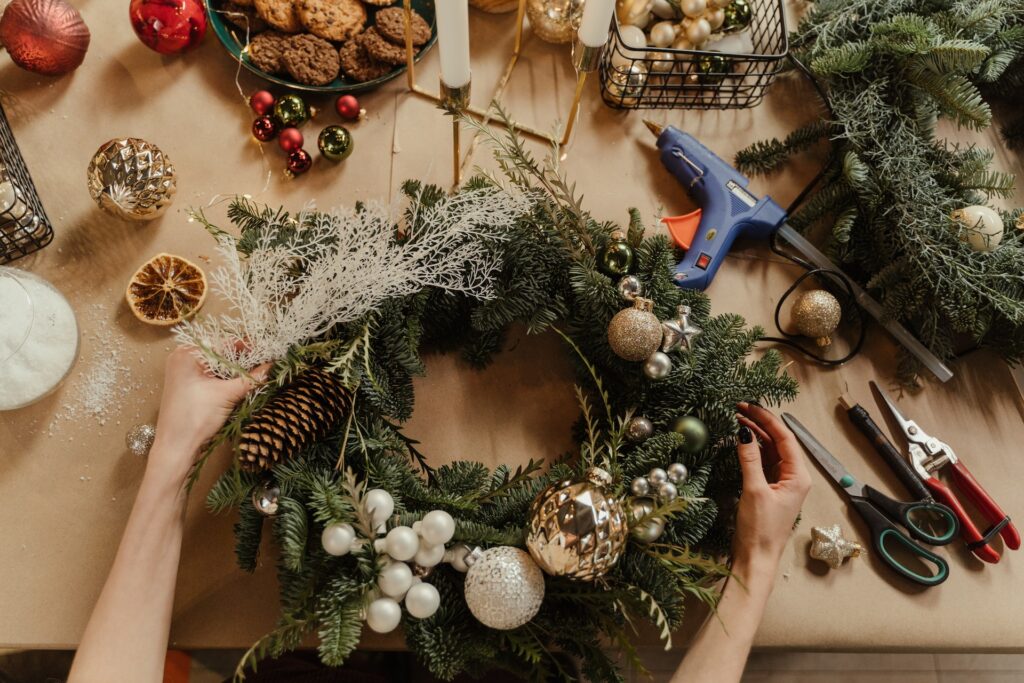When should you use a hot glue gun?
There were times early in my crafting journey when I wondered when I should use a hot glue gun and when I should not. A hot glue gun is a versatile tool that can be used for a variety of craft projects, from gluing together pieces of fabric to adhering embellishments to a project. However, it’s important to remember that not all projects are appropriate for hot glue use. Knowing when to use it and when not to, can help you make the most of your crafting experience. In this post, I try to collate the information I have gathered over the years about how to use a hot glue gun, when to use it and when not to use it, and some tips that I learned using it over time. I will also list some of my favorite ones at the end of the post. So let’s get started.
Hot glue gun as the name indicates is nothing but a device used to melt and help apply the glue to bonding surfaces. They are particularly suitable for domestic use and are therefore ideal for bonding materials such as wood, glass, leather, plastic, cardboard, aluminum, pebble, and fabric. Why use hot glue instead of just ‘glue’? Simply because it is used for bonding hard-to-glue materials. It’s not for delicate items or anything that cannot stand the heat. So ideally the material that you want to use the glue on decides whether you want to go for hot glue or regular water-based adhesives. Hot glue is also not ideal in very high-heat or cold environments, especially since hot glue can break in cold weather and can become supple during very high temperatures. This breaking temperature can depend on the specific hot glue you are working with and might be a point of consideration when you decide on the glue you want to work with.
Now what is the mechanism behind the hot glue gun?
A Hot Glue gun can be simply understood as a handheld device like the one in the picture above that heats and melts solid glue sticks using an electric heating element. The melted glue is then pushed out through the gun’s nozzle onto the crafting surface to bond materials. Hot glue guns are great for so many projects. The bond formed is very strong and the glue adheres to all kinds of materials. Hot glue with a glue gun application is great because it sets quickly and can hold a variety of materials together. Now there is one important safety tip to remember while using a hot glue gun. As the name indicates, hot glue is HOT! So Caution should be taken to ensure that you don’t get some accidently on your skin! So it’s important to remember that hot glue should generally be used by adults and older kids under adult supervision at all times.
Glue guns generally come in two basic sizes: standard or miniature. Both have their pros and cons. Miniature size is easier to hold. They also have precision tips that dispense smaller amount of glue and hence makes them ideal for intricate crafting uses. However, due to their size, they use much smaller glue sticks, therefore you run out of glue more quickly. Standard size is larger ones and can hold bigger glue sticks but might not be suitable for really intricate work. They might also not be ideal for smaller hands. The larger dispenser tip also sometimes causes a large amount of glue to get stuck to the tip when dried. So depending upon the intended usage, one might opt for the mini or the standard glue gun. But one needs to keep in mind that you will not be able to interchange the glue sticks between mini and standard. You will have to get mini glue sticks for the mini and the standard-size glue sticks for the standard glue gun.
Types of Hot Glue Guns
Next, you probably might come across three different categories of glue guns. Their differences lie in the operating temperatures, intended application and environment, and heating time, as discussed below.
High-Temperature Hot Glue Gun
As the name implies, this gun melts the glue stick at high temperatures of around 190ᵒC. They can heat up very quickly. They are suitable for bonding heavy-duty materials such as wood and strong plastics. It follows that they aren’t recommended for use on delicate materials that can easily be damaged by high heat. High-temperature glue guns work best for industrial work, small DIY tasks, or simple home repair projects. Caution should be taken when using high-temperature glue guns, due to the obvious high-temperature glue involved.
Low-Temperature Guns
Low-temperature guns are usually much smaller and cheaper than high-temperature hot glue guns. But despite the name, low-temperature guns can still get extremely hot, reaching temperatures of approximately 120ᵒC. As such, I recommend that you use them with the same caution you would when using high-temperature glue guns.
Given their lower operating temperatures, low-temperature glue guns are slightly safer to use than hot glue guns. They work best on lighter materials and are ideal to use for smaller arts and crafts projects.
Dual Temperature Hot Glue Guns
Dual-temperature glue guns allow you to control the melting temperature according to your preferences. This makes them the more versatile option, but also the most expensive option of the three.
If you’ve used a hot glue gun, you’ve most likely experienced the “stringing” of the adhesive and the ugly glue “strings” that can get left behind on your project. And why does it string you may ask? Stringing occurs with hot melt adhesives when some of the glue material sticks to the applicator nozzle and then the glue is pulled down.
Steps to follow when using a Hot Glue gun
Step 1: First start by preparing the area you’ll be working in. Use a self-healing cutting mat to prevent the glue from damaging the work area or other surfaces.
Step 2: Once your work area is ready, the next step is to insert a glue stick in the gun and turn it until it reaches the desired temperature. It will typically take as little as a minute for the glue to get hot. Rest the glue gun on the work area using the built-in stand while you wait in between applications.
Step 3: While you’re waiting for the glue gun to reach the right temperature, use the time to prepare the items you wish to glue. Make sure all the surfaces are completely dry and free from dust, grease, or other debris.
Step 4: Now that everything is prepared, it’s time to start applying the hot glue. It is advisable to do a patch test first before applying the glue directly on the surface. Hold the nozzle over the test patch and gently squeeze the trigger of the glue gun until the glue starts dispensing on the test patch. It should be a smooth and consistent flow. If all is well, you can use the glue gun on the actual surface you want to work on. Move the glue gun along the length of the surface and ease the trigger as you reach the end.
Step 5: So how long does it take for the hot glue to dry? Allow 10 minutes to ensure the glue has adequate time to set before moving the object you are working on. But if you’re not pressed for time, best to allow 12 hours for the glue to harden.
Step 6: Now time for the finishing touches. After applying the glue to the surface, place the glue gun in an upright position using the inbuilt stand over the cutting mat. And that’s it!
Safety Tips When Using Glue Guns
As mentioned, irrespective of whether you’re using high or low-temperature glue guns, safety is paramount. Always follow these safety tips:
- It is recommended to use finger protectors(usually made from silicone) to prevent the hot glue from burning your fingertips accidentally.
- Use a self-healing cutting mat on top of your work surface while working with a hot glue gun. This is because any glue that drips off onto the mat, once dried can easily be chipped off from the cutting mats and will not leave any residue.
- Use a drip cup to catch the drip from the glue guns when you lay it to rest.
- Keep the glue away from flammable materials.
- Give your undivided attention to the gluing task at all times, to prevent unnecessary accidents.
- Never leave a plugged-in glue gun unattended.
- What you need to consider before buying a hot glue gun
Before purchasing a hot glue gun there are key factors you must take into consideration:
Intended Application: What do you intend to use the gun for? Is it for simple arts and crafts hobbies or industrial and professional use? Pick low-temperature guns for simple tasks and high-temperature guns for heavy-duty tasks.
Size: With glue guns, you’ll find lightweight, medium, and heavy-weight units. Lightweight guns can weigh as little as 250g and are ideally suited for low-level use. Medium-duty guns weigh around 500g and can be used for intricate jobs such as ducting or shop fitting. Heavy-duty guns can be as heavy as 2.3kg and are suited for high-level uses such as architectural bonding or product assembly.
Heating time: Consider how fast the unit takes to heat up. Heavy-duty guns usually allow for fast warm-up compared to their lightweight counterparts.
Power: Do you want a glue gun that’s electronically or battery operated or to be used with compressed air? Battery-operated glue guns come in handy for applications where main power isn’t available. Alternatively, you can also opt for gas-powered glue guns, which are powered by small canisters of butane gas easily available in hardware and trade supply shops.


